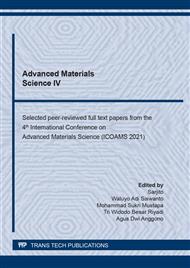[1]
D. R. Buddy, A. S. Hoffman, F. J. Schoen, J. E. Lemon, Biomaterials Science, An Introductions to Materials in Medicine 2ndEdition, Elsevier, California USA, (2004).
Google Scholar
[2]
H. Lee, D. Kim, J. Jung, D. Pyon, K. Shin, Corrosion Science, 51, pp.2826-2830, (2009).
Google Scholar
[3]
C. Oldani, A. Dominguez, (2012). Titanium as a Biomaterial for Implants: Recent Advances in Arthroplasty ISBN: 978-953-307-990-5, InTech, (2012).
DOI: 10.5772/27413
Google Scholar
[4]
G. Manivasagam, D. Dhinasekaran, A. Rajaminickam, Biomedical implants: Corrosion and its Prevention – a Review, (Recent Patents on Corrosion Science 2, pp.40-54, (2010).
DOI: 10.2174/1877610801002010040
Google Scholar
[5]
V. Malau, B. H. Priyambodo, P. T. Iswanto, T. Sujitno, Suprapto, Increased Hardness, Corrosion Resistant and Corrosion Fatigue Cracking Performance on AISI 304 by DC Sputtering, International Review of Mechanical Engineering (I.RE.M.E.), 12, pp.975-980, (2018).
DOI: 10.15866/ireme.v12i12.15901
Google Scholar
[6]
M. Benedetti, B. Fontanari, P. J. Winiarski, M. Withers, J. C. Allahkarami, Hanan, Procedia Engineering, 109, (2015).
DOI: 10.1016/j.proeng.2015.06.210
Google Scholar
[7]
B. H. Priyambodo, V. Malau, P. T. Iswanto, T. Sujitno, Suprapto, The Influence of TiN-Sputtering on Hardness and Corrosion Rate of AISI 304 for Biomaterials Application, Journal of Corrosion Science and Engineering, 20, (2017).
DOI: 10.15866/ireme.v12i12.15901
Google Scholar
[8]
D. L. Rios, A. Walley, M. T. Milan, G. Hammersley, Fatigue Crack Initiation and Propagation on Shot-Peened Surfaces in A316 Stainless steel, International Journal of Fatigue, 17, pp.493-499, (1995).
DOI: 10.1016/0142-1123(95)00044-t
Google Scholar
[9]
O. Unal, R, Farol, Surface Severe Plastic Deformation of AISI 304 via Conventional Shot Peening, Severe Shot Peening, and Repenning, Journal Surface Science, 351, p.289–295, (2015).
DOI: 10.1016/j.apsusc.2015.05.093
Google Scholar
[10]
B. H. Priyambodo, Suhartoyo, S. Slamet, Increased Corrosion Resistance on Cu35%Zn Surface by Shot Peening Process, Journal of Physics: Conference Series, 1430(1), 012055, (2020).
DOI: 10.1088/1742-6596/1430/1/012055
Google Scholar
[11]
G. H. Majzoobi, J. Nemati, A. J. Novin, Rozz, G. H. Farrahi, Tribology International, 42, (2009).
Google Scholar
[12]
H. Mohassel, F. Malekabadi, M. Jebreili, M. Zehsaz, F. Vakili-Tahami, Effect of Shot Peening on Tribological Behaviors of Molybdenum-Thermal Spray Coating using HVOF Method, Tribology In Industry, 39, pp.100-109, (2017).
DOI: 10.24874/ti.2017.39.01.11
Google Scholar
[13]
W. Kim. J. S. Park, S. W. Cho, N. R. Kim, I. Y. Ko, I. J. Shon, Properties and Rapid Consolidation of Binderless Titanium Nitride by Pulsed Current Activated Sintering, Journal of Ceramic Processing Research, 11, pp.627-630, (2010).
Google Scholar
[14]
K. Zhan, C. H. Jiang, X. Y. Wu, V. Ji, Surface Layer Characteristics of S30432 Austenite Stainless Steel After Shot Peening, Materials Transactions, 53, No. 5, pp.1002-1006, (2012).
DOI: 10.2320/matertrans.m2011390
Google Scholar
[15]
B. H. Priyambodo, V. Malau, P. T. Iswanto, L. D. Setyana, S. Slamet, and Y. Kurniawan, Improve corrosion resistant and corrosion fatigue cracking performance on AISI 304 by shot peening process as alternative biomaterials, J. Corros. Sci. Eng., vol. 22, (2019).
DOI: 10.15866/ireme.v12i12.15901
Google Scholar
[16]
Margono, B. H. Priyambodo, R. I. Yaqin, hot Peening on AISI 304 by Various Sizes of Steel Ball Particles to Reduce Corrosion Rates, J. Corros. Sci. Eng., vol. 23, (2021).
Google Scholar
[17]
G. S. Junior, J. C. Voorwald, L. F. S. Vieira, M. O. H. Cioffi, R. G. Bonora, Evaluation of WC-10Ni Thermal Spray Coating with Shot Peening on The Fatigue Strength of AISI 4340 Steel, Procedia Engineering, 2, p.649–656, (2010).
DOI: 10.1016/j.proeng.2010.03.070
Google Scholar
[18]
ASTM G5-94, Standard Reference Test Method for Making Potentiostatic and Potentiodynamic Anodic Polarization Measurement, (1999).
Google Scholar
[19]
D. Xiong, Y. Yang, Y. Deng, Bio-Tribological Properties of UHMWPE Against Surface Modified Titanium Alloy, (2013).
DOI: 10.1016/j.surfcoat.2012.05.033
Google Scholar
[20]
L. Kang, A. L. Galvin, T. D. Brown, Z. Jin, J. Fisher, Quantification of the effect of cross-shear on the wear of conventional and highly cross-linked UHMWPE, (2008).
DOI: 10.1016/j.jbiomech.2007.09.005
Google Scholar
[21]
S. Ge, X. Kang, Y. Zhao, One-year Biodegradation Study of UHMWPE as Artificial Joint Materials: Variation of Chemical Structure and Effect on Friction and Wear Behavior, (2011).
DOI: 10.1016/j.wear.2010.11.048
Google Scholar
[22]
G. Singh, H. Singh, B. S. Sidhu, Characterization and Investigation of In-Vitro Corrosion Behavior of Plasma Sprayed Hydroxyapatite and Hydroxyapatite–Calcium Phosphate Coatings on AISI 304. Journal of Corrosion Science and Engineering, 17, (2014).
DOI: 10.1016/j.apsusc.2013.08.013
Google Scholar


